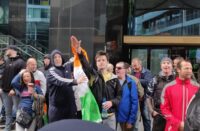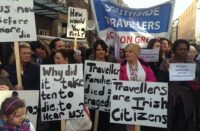We are told that public education is free. However, you don’t need to look very far into how the public education system works to see that this simply isn’t true.
The public school system, which is supposed to be financed by the tax that working people pay, is filled with further payments, such as for new books and uniforms, which are needed each new school year. These fees are a further burden on the working class and create a block to further education, as the fees for entering third level are the highest in Europe.
In late November students around the country, in protests organised by the Union of Students in Ireland, stood up against these fees.
Not only is it not free but public education is also influenced by the state in shaping how the youth of the country view the state and, more generally, the world. Within the teaching of Irish history we are never told of the socialist ideas of the Marxist James Connolly. James Connolly’s leadership of the Irish Citizen Army, an army composed and led by the Irish proletariat, is omitted from the curriculum, as is the event that led to its founding, the 1913 lockout.
The role the Soviet Union played in the Second World War in holding the eastern front and pushing back against Germany is understated, and its fighting against Japan is omitted. The advances that the Soviet Union made industrially and socially before, during and after the war are not taught; instead, unsubstantiated lies are pushed into the school curriculum.
The 1960s civil rights movement in America and its progressive outcome, we are told, were from peaceful protests and speeches that combated the status quo but did not interfere with the general working of the state. But the riots throughout America that interfered with the workings of the state are the reason for the social change at the time, and not liberal ideas that the morals of the state were changed.
The socialist leaders and theorists throughout history are vilified by the state for succeeding and their assassination celebrated by the same state.
The influence of the ruling class on the education of our country’s youth can be seen throughout primary, secondary and third-level education. However, the Catholic Church’s influence on primary and secondary education cannot be ignored. Its effect on science subjects and on sex education has been a hindrance to Ireland’s youth for many years. They are denied a full, expansive education in the sciences, as parts fundamental to biology are overlooked because they go against the Catholic Church’s teachings.
The Catholic Church’s influence over school also alienates those of other religions, as even learning about religion concentrates mainly on Christianity through a Catholic view. Such religions as Judaism, Buddhism, Hinduism and Islam are overlooked in the education system, even though the morning, lunchtime and evening prayers have nothing to do with non-Christian religions.
In Russia before the October Revolution illiteracy was more than 60 per cent. After the revolution the new socialist government began making changes to the education system to promote literacy throughout the population. Preliminary exams required for entering university were abolished, and all lectures were made free to attend. Native languages were taught in schools to pupils who were not native Russians.
The Soviet Union was the first socialist state. Its reforms in the education system were an inspiration to other socialist states, such as Cuba. In Cuba before Fidel Castro led the workers against Fulgencio Batista the literacy rate was 77 per cent, but when Castro took power he believed all people in Cuba should be able to read and write. In 1960 the Cuban literacy campaign began, with the aim that all adults would be literate within a year. Schools were built throughout the countryside, and literacy grew among the Cuban people.
Today, according to UNESCO, the literacy rate in Cuba is 99 per cent—the same as the rate in Ireland. Schooling in Cuba is free for all children, with no exception. The school system provides a scholarship plan that guarantees accommodation, food and, in cases where they’re needed, uniforms, all free. Cuba also has one of the highest teacher-to-pupil ratios, with 1 teacher to 20 pupils. Many of the schools open from 6:30 a.m. and don’t close for twelve hours, providing free morning and after-school care for the children of working parents.
The education system of Cuba is built upon the needs of the children and the working people, not the needs and wants of the state.
We must look at how our education system is run, what influences it and how we can change it so we can have an education system made within working people’s interests. Access to education should not be limited by one’s wealth but should be free and open to all.






